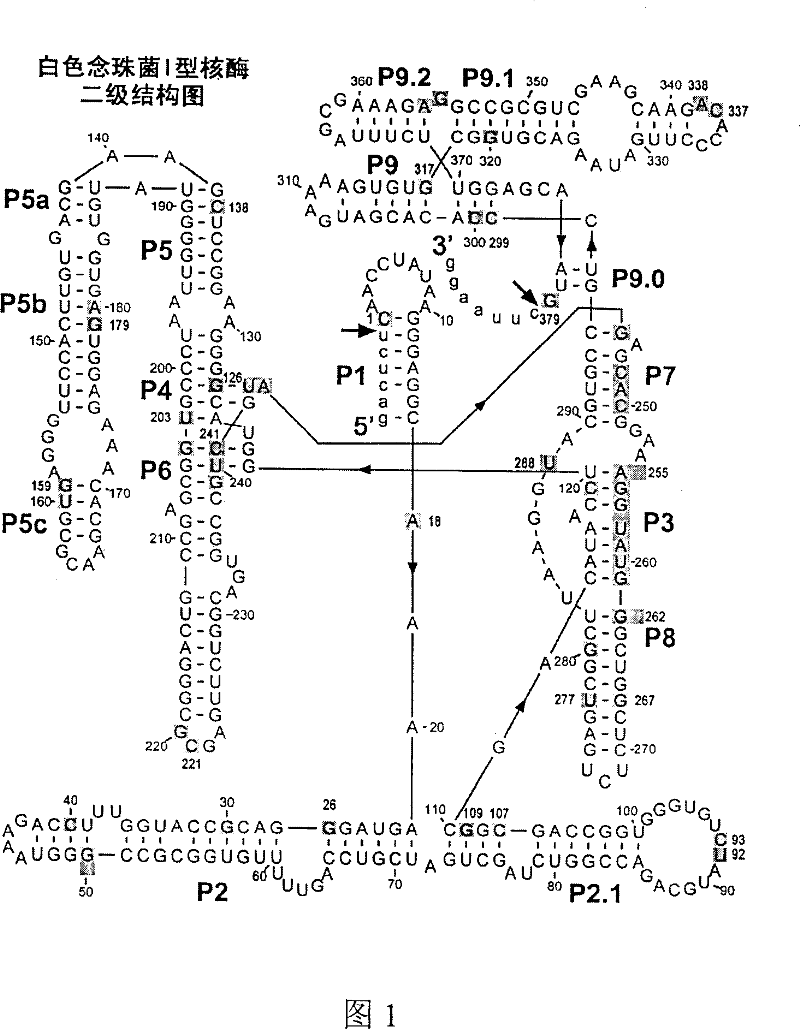Antisense oligonucleotide sequence resistant to Candida albicans infection and its uses
An antisense oligonucleotide and sequence technology, applied in the field of application in the treatment of Candida albicans infection, can solve problems such as strong side effects
- Summary
- Abstract
- Description
- Claims
- Application Information
AI Technical Summary
Problems solved by technology
Method used
Image
Examples
Embodiment 1
[0046] Example 1: Screening of antisense oligonucleotides for inhibition of self-cleavage of Candida albicans type I ribozyme during in vitro transcription.
[0047] The applicant has designed 21 oligonucleotides (1-26R, 18-40R, 30-50R, 50-68R, 69-92R, 93- 109R, 107-126R, 120-138R, 137-159R, 160-179R, 180-203R, 204-220R, 221-241R, 239-262R, 255-277R, 267-288R, 280-300R, 299-320R, 317-338R, 337-359R, 356-379R, synthesized by Sebasant), they cover the entire ribozyme sequence and have the same Tm value (annealing temperature). Then, the antisense oligonucleotide that can effectively inhibit the self-cleavage system among the 21 antisense oligonucleotides was screened by the self-cleavage reaction system of type I intron ribozyme in Candida albicans 26S rRNA. The specific embodiment is: in the self-cleavage system of the type I intron ribozyme in Candida albicans 26SrRNA, the intron of the self-cleavage ribozyme is 379 nucleotides, and the 5' exon is 129 nucleotides. nucleotide...
Embodiment 2
[0056] Example 2: Confirmation of important sites in the core pseudoknot region affecting ribozyme activity
[0057] It has been determined by Example 1 that the core pseudoknot region of the type I intron ribozyme in Candida albicans 26S rRNA is very sensitive to antisense oligonucleotides, and targeting this region by antisense oligonucleotides will cause ribozyme Strong inhibition of self-cleavage reactions, and RNase H cleavage experiments also showed that all oligonucleotides were bound at the correct positions. The next step is to further identify the nucleotides in the core pseudoknot region that are important for the self-cleavage activity of the ribozyme. The specific embodiment is: first fix the G of the core pseudoknot region of the I-type intron ribozyme in the Candida albicans 26S rRNA 235 site, followed by G 235 → The direction of the 3' end is designed to shorten the length of the antisense oligonucleotide; similarly fix the G of the core pseudoknot region 26...
Embodiment 3
[0070] Example 3: Observation of Candida albicans absorption of antisense oligonucleotides by confocal fluorescence microscope
[0071] It has been proved by experiments that antisense oligonucleotides targeting the core pseudoknot region of type I intron ribozyme in Candida albicans 26S rRNA can cause strong inhibition of ribozyme self-cleavage reaction, but in Candida albicans Whether antisense oligonucleotides in vivo can cause strong inhibition of ribozyme self-cleavage reaction is the concern of the present invention. But how to introduce these antisense oligonucleotides targeting the core pseudoknot of Candida albicans type I ribozyme into the body of Candida albicans is a key problem. Studies have shown that Candida albicans is an excellent system for transporting antisense oligonucleotides, which can enrich antisense oligonucleotides into Candida albicans so that the concentration of antisense oligonucleotides in the body reaches 10 times that in vitro . And antisens...
PUM
 Login to View More
Login to View More Abstract
Description
Claims
Application Information
 Login to View More
Login to View More - R&D
- Intellectual Property
- Life Sciences
- Materials
- Tech Scout
- Unparalleled Data Quality
- Higher Quality Content
- 60% Fewer Hallucinations
Browse by: Latest US Patents, China's latest patents, Technical Efficacy Thesaurus, Application Domain, Technology Topic, Popular Technical Reports.
© 2025 PatSnap. All rights reserved.Legal|Privacy policy|Modern Slavery Act Transparency Statement|Sitemap|About US| Contact US: help@patsnap.com



